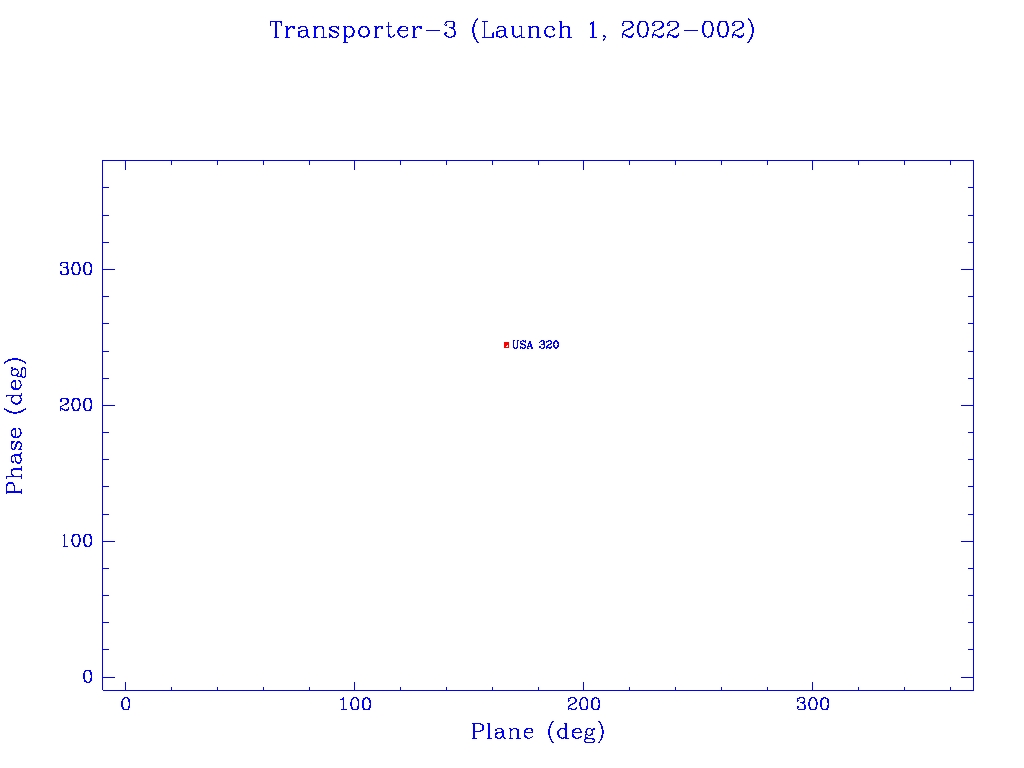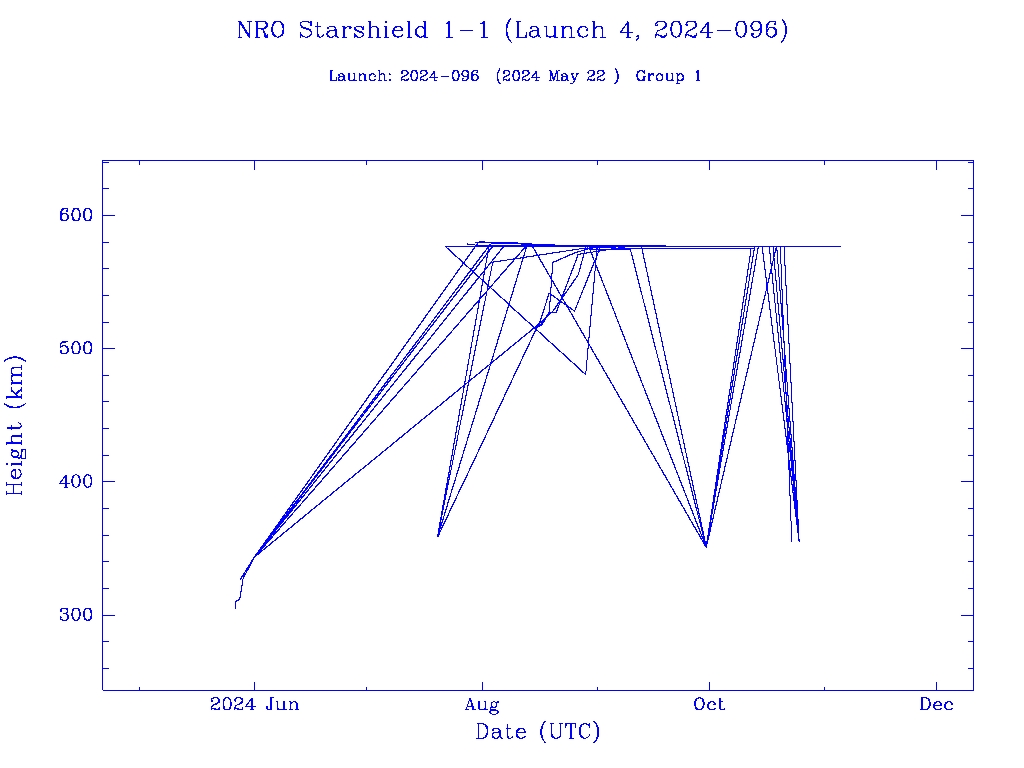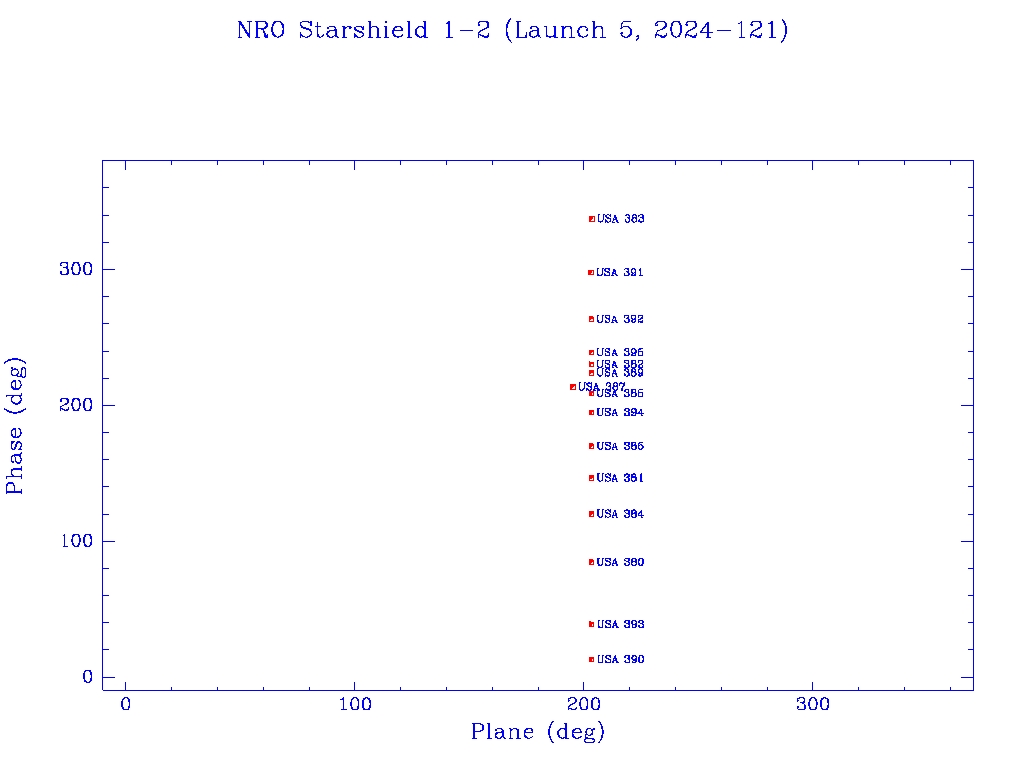Starshield Launch Statistics
All altitudes in km.
Constellation description not yet available
Summary status table
Data last updated: 2025 Feb 02 01:38:19
| Mission | Total Sats Launched | Failed to orbit | Early Deorbit | Disposal Complete | Reentry after Fail | Total Down | Total In Orbit | Screened | Failed, decaying | Graveyard | Total Working | Disposal underway | Out of constellation | Anom. | Reserve, Relocating | Special | Drift | Ascent | Operational Orbit | Orbit Heights | Phase vs Plane | Plane vs Time |
|---|---|---|---|---|---|---|---|---|---|---|---|---|---|---|---|---|---|---|---|---|---|---|
| f | F | R | M | F | M | G | R | L | U | T | S | D | A | O | ||||||||
| Starshield prototypes | 8 | 0 | 0 | 4 | 0 | 4 | 4 | 0 | 0 | 0 | 4 | 0 | 0 | 0 | 0 | 0 | 0 | 0 | 4 | |||
| Starshield cluster launches | 124 | 0 | 0 | 0 | 0 | 0 | 124 | 0 | 0 | 0 | 124 | 0 | 0 | 0 | 0 | 0 | 75 | 1 | 48 | |||
| Starshield pair launhces | 6 | 0 | 0 | 0 | 0 | 0 | 6 | 0 | 0 | 0 | 6 | 0 | 0 | 0 | 0 | 0 | 2 | 0 | 4 | |||
| Total | 138 | 0 | 0 | 4 | 0 | 4 | 134 | 0 | 0 | 0 | 134 | 0 | 0 | 0 | 0 | 0 | 77 | 1 | 56 |
Note: The letters are those used in byte 8 of the SatType code in the GCAT satellite catalog entries.
- Sats: Total number of satellites launched.
- Failed to orbit (f): Launch vehicle failed to reach orbit.
- Down (F) Early deorbit: satellites which have reentered; determined to be malfunctioning before reaching operational orbit, and abandoned or actively lowered prior to reentry.
- Down (R) Disposal, later semicontrolled reentry: satellites which reached the operational orbit but whose orbits were later lowered to cause early reentry. These satellites retained propulsive capability but either failed in some other respect or were deliberately retired.
- Down (M) Reentry after fail; Later uncontrolled reentry: Reentered after an extended period of uncontrolled orbital decay; presumed failed.
- Total down: Total of satellites which were launched but are not currently in orbit.
- Total in orbit: Total of satellites which reached orbit and have not yet reentered, whether working or not.
- Screened (F): Satellites not working correctly and left in low orbit prior to completing orbit raising; expected to reenter soon. Includes satellites that failed at launch.
- Dead (M): Failed, uncontrolled decay. Satellites stopped stationkeeping after reaching operational orbit; no manuevers occurring, presumed failed.
- Graveyard (G): Graveyard orbit, retired. Not used for Starlink.
- Total working: Total of satellites still in orbit minus those thought failed (screened or uncontrolled decay).
- Retiring (R): Disposal. Orbit lowering to semicontrolled reentry underway
- Lowered (L): Out of con(stellation). Satellites which were operational but have been removed from the operational shell; still actively maneuvering.
- Anomalous (U): Satellites lowered to an intermediate orbit height but stationkeeping. I suspect these satellites are not fully operational, but not yet abandoned - perhaps SpaceX hopes to debug their problems.
- Reserve (T): Satellites maintained in an orbit close to the operational one, relocating in phase or temporarily out of the constellation. As of mid 2023 I am not bothering to mark T status most of the time for Starlink as a lot of satellites are popping in and out of this status on a daily basis.
- Special (S): Satellites making unusual manuevers, suspected to be being used for special tests.
- Drift (D): Satellites maintained at an intermediate altitude undergoing targeted orbital plane drift.
- Ascent (A): Satellites currently orbit raising towards operational altitude
- Op Shell (O): Satellites in one of the operational shells.
Note that I am only talking about the orbital status here - satellites that are not in the `operational orbit' may nevertheless be
providing operational service.
The actual altitude of shells is not always the same as the licensed altitude. Therefore, for newly occupied shells, it may be a while before I can distinguish between 'satellite is at final altitude' and 'satellite was just plane drifting and final altitude is somewhere different'. Thus, satellites which were tentatively marked 'O' can later be downgraded to 'D' or 'A' once the shell altitude is better known.
List of all Starshield satellites and their orbital history
Click on mission name for details of individual satellites. Phase/Plane plots only include satellites in`operational orbit' (status = O)
Data last updated: 2025 Feb 02 01:38:05
| Mission | Total Sats Launched | Failed to orbit | Early Deorbit | Disposal Complete | Reentry after Fail | Total Down | Total In Orbit | Screened | Failed, decaying | Graveyard | Total Working | Disposal underway | Out of constellation | Anom. | Reserve, Relocating | Special | Drift | Ascent | Operational Orbit | Orbit Heights | Phase vs Plane | Plane vs Time |
|---|---|---|---|---|---|---|---|---|---|---|---|---|---|---|---|---|---|---|---|---|---|---|
| f | F | R | M | F | M | G | R | L | U | T | S | D | A | O | ||||||||
| Transporter-3 (Launch 1, 2022-002) | 4 | 0 | 0 | 4 | 0 | 4 | 0 | 0 | 0 | 0 | 0 | 0 | 0 | 0 | 0 | 0 | 0 | 0 | 0 |  |  |  |
| Globalstar FM15 (Launch 2, 2022-064) | 4 | 0 | 0 | 0 | 0 | 0 | 4 | 0 | 0 | 0 | 4 | 0 | 0 | 0 | 0 | 0 | 0 | 0 | 4 |  |  |  |
| Starlink Group 7-16 (Launch 3, 2024-050) | 2 | 0 | 0 | 0 | 0 | 0 | 2 | 0 | 0 | 0 | 2 | 0 | 0 | 0 | 0 | 0 | 0 | 0 | 2 |  |  |  |
| NRO Starshield 1-1 (Launch 4, 2024-096) | 21 | 0 | 0 | 0 | 0 | 0 | 21 | 0 | 0 | 0 | 21 | 0 | 0 | 0 | 0 | 0 | 0 | 0 | 21 |  |  |  |
| NRO Starshield 1-2 (Launch 5, 2024-121) | 21 | 0 | 0 | 0 | 0 | 0 | 21 | 0 | 0 | 0 | 21 | 0 | 0 | 0 | 0 | 0 | 5 | 1 | 15 |  |  |  |
| NRO Starshield 1-3 (Launch 6, 2024-160) | 21 | 0 | 0 | 0 | 0 | 0 | 21 | 0 | 0 | 0 | 21 | 0 | 0 | 0 | 0 | 0 | 9 | 0 | 12 |  |  |  |
| NRO Starshield 1-4 (Launch 7, 2024-192) | 17 | 0 | 0 | 0 | 0 | 0 | 17 | 0 | 0 | 0 | 17 | 0 | 0 | 0 | 0 | 0 | 17 | 0 | 0 |  |  |  |
| NRO Star/Starlink N1 (Launch 8, 2024-225) | 2 | 0 | 0 | 0 | 0 | 0 | 2 | 0 | 0 | 0 | 2 | 0 | 0 | 0 | 0 | 0 | 2 | 0 | 0 |  |  |  |
| Starshield 6 (Launch 9, 2024-243) | 22 | 0 | 0 | 0 | 0 | 0 | 22 | 0 | 0 | 0 | 22 | 0 | 0 | 0 | 0 | 0 | 22 | 0 | 0 |  |  |  |
| Starshield 7 (Launch 10, 2025-005) | 22 | 0 | 0 | 0 | 0 | 0 | 22 | 0 | 0 | 0 | 22 | 0 | 0 | 0 | 0 | 0 | 22 | 0 | 0 |  |  |  |
| Starlink Group 13-1 (Launch 11, 2025-014) | 2 | 0 | 0 | 0 | 0 | 0 | 2 | 0 | 0 | 0 | 2 | 0 | 0 | 0 | 0 | 0 | 0 | 0 | 2 |  |  |  |